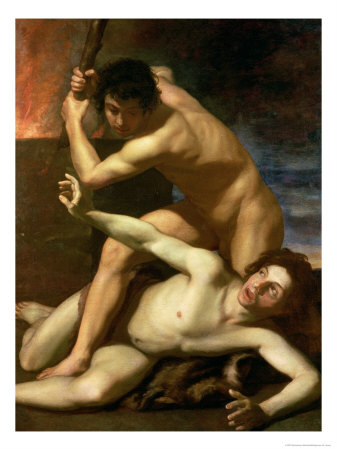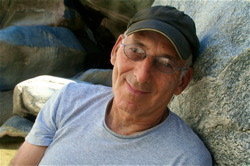Book Review: Violence, a la the Freudian and Biblical canon
Short Fuse thinks Russell Jacoby’s Bloodlust: On the Roots of Violence from Cain and Abel to the Present is an unconvincing mix of refurbished Freudianism and Genesis.
Bloodlust: On the Roots of Violence from Cain and Abel to the Present by Russell Jacoby. Free Press, 256 pages, $24.
The subtitle of Russell Jacoby’s new book—On the Roots of Violence from Cain and Abel to the Present—announces an ambition at once vast and oddly delimited. Did human violence begin when Cain slew Abel, as per a Hebrew text composed no more than 3,000 years ago? Does this imply that there was no violence among our kind in the hundreds of thousands of years prior to the redaction of tales that come down to us in Biblical scripture? Or does Jacoby mean to say that pre-Biblical violence is beyond the scope of his book because its root system somehow differs from that which underlies the violence he will examine?
Quibbling over a subtitle is a less than ideal way to begin a book review, subtitles being devised as much by editors as by authors, but this slim volume—”an essay, not a tome” as per Jacoby—arouses so many doubts, questions, protestations and refusals along its way—a tome’s worth—that one may as well start at the titular beginning. Still, the problem with the book goes beyond the reservations aroused en route to the conclusion: the problem is the conclusion.
Jacoby has earned his place in American letters as an author of jargon-free, iconoclastic works, including Social Amnesia: A Critique of Contemporary Psychology (1975) and The Last Intellectuals: American Culture in the Age of Academe (1987). But there’s nothing iconoclastic about Bloodlust. In the same spare prose for which he has been praised, Jacoby commits himself, this time, not to paring away but to resuscitating dogma—that of Freudian orthodoxy.
Jacoby delves into the Freudian corpus, as into Genesis, does some exegesis—bits of rewiring here and there—and sets a rejiggered Freud back into place as nothing less than the Master Narrator he has, for most of us, long since ceased to be and can never be again. Nor does Jacoby bother with an apology for or defense of Freud. This lends something of a time warp quality to Bloodlust.
For Jacoby it seems that Freud has never been unseated or even seriously challenged, not seriously enough for Jacoby to deal with the tomes of objections—the death by a thousand critical cuts—Freudianism has endured. Freud just rules, presides again, as back in the day.
In his preface, Jacoby deploys his well-honed, polemical skills less to promoting what he takes to be the Freudian solution to the problem of violence than to mocking at and dismissing alternate views of the subject. We learn right off that Bloodlust will shun the “sociobiological approach” and make no use of anything “Darwin or DNA” might add to the discussion. Jacoby allows that there have, in fact, been “advances in genetics and evolutionary biology.” (The term Jacoby really wants here is “evolutionary psychology,” which pertains not to frogs, bugs or bacteria but specifically to human minds. However he disdains “the biological” too thoroughly to trouble with nomenclature.)
In any case, Jacoby is “wed” not to “biology and chemistry” but “to history”—history, if it’s history at all, of a certain sort. It’s definitely not the sort of history that invokes a “scenario of clashing civilizations” as proposed by the likes of Samuel Huntington—that being precisely the school of thought to which Bloodlust means to deliver a knockout blow. For Jacoby, the driving force of violence is not others contesting with others over ideas, religions, territories, culture, status, and wealth but brothers contending with brothers, neighbors with neighbors, like with like.
(Cain and Abel serve naturally as his paradigmatic fable, followed by Esau contending with Jacob. But aside from Cain killing Abel, strife among brothers in the Hebrew Bible, a default condition to be sure, ends mostly in reconciliation, however strenuously attained. And other literary traditions highlight intense, fraternal affection, as in Gilgamesh’s love for Enkidu—not his brother but as good as—in the Epic of Gilgamesh. As noted, quibbles with Bloodlust multiply.)
To maintain, as Jacoby does, that likeness is overall more lethal than perceived difference calls for a prodigious amount of explaining away and flattening out of experience. Jacoby goes at the task with true Freudian vigor. His account of the murderous persecution in 16th-century France of Huguenots by Catholics ignores the religious differences that were obviously operative between them. Catholics and Huguenots were French, after all, and French speaking. That they spoke different religious tongues is irrelevant, for Jacoby. The Catholic persecution of Huguenots was fratricide.
But religious differences, then as now, tend to involve more than disputes about doctrine. They extend as much to tradition, family ties, who one loves and who one fears—matters of blood, core aspects of identity. None of this registers on Jacoby. Given that Bloodlust is an essay, not a tome, the book devotes undue attention to details of the atrocities visited on the Huguenots, as if the minutia of gore, not hard to come by in the course of history, were an argument that might somehow strengthen Jacoby’s case. It doesn’t. It’s inordinate and sows doubt.
Jacoby’s urge to flatten out difference reaches absurd lengths when he writes that World War II, “presents a paradigmatic case of fratricide: the extermination of the Jews. . . . German Jews were extraordinary assimilated and successful. . .German anti-Semitism targeted neighbors not strangers.” But even a casual glance at German history shows that the assimilation of Jews, a la Weimar (and much of the rest of Europe), was recent, its status contested and insecure. All it took, in brief, was a German defeat in the First World War, a ruinous Depression, the charismatic psychotic called Hitler—throw in a bit Wagner and anti-Bolshevism as necessary—and German Jews were assimilated no more, marked, marked down, as alien and ancestral malefactors.

Cain and Abel — For Jacoby, the driving force of violence is not others contesting with others over ideas, religions, territories, culture, status and wealth — but brothers contending with brothers, neighbors with neighbors, like with like.
In any case, the assimilation of German Jews was always incomplete. Profound cultural and intellectual differences apply that Jacoby, as is his wont, disallows. The novelist E. L. Doctorow gets at these (in an interview with Richard Trenner) when he says:
The Jews [the Nazis] went after—the Jews who most enraged them—were the assimilated Jews. . . Einstein, for instance, infuriated the Nazis. Einstein was coming up with a universe in which nothing stayed the same very long. . . They saw all this relativism as a great threat to their psychic security and a typically Jewish maneuver to undercut and destroy the Aryan race. It was not the pious, practicing Jews who kept to themselves who so much enraged the Nazis at the beginning. It was the Jewish professors and composers (like Mahler) and scientists. . . The number of poets, novelists, critics, painters, and musicians whom they destroyed. Migod [how many they murdered.]
To this list Doctorow might have added Freud himself, whose lifework, no less than Einstein’s, infuriated Nazis. But for Jacoby what matters is that these and other German Jews spoke German and not, perhaps, Yiddish. Quite a few were successful, prominent. How then were they not German, and was their extermination not a case of fratricide?
Jacoby’s approach to this material shows him, finally, to be wed not really to history at all but to mythology—he mythos of Freudianism. Jacoby falls back repeatedly on Freud’s notion of the narcissism of minor differences,”hostility engendered by small disparities.” It’s an interesting notion but stretched past its breaking point when used as a rubric for violence “from Cain and Abel to the Present.”
Nor did the “small disparities” Jacoby alludes to seem quite that small to those who lived them. When Franz Kafka learned that Walter Rathenau—for a brief time Weimer’s Jewish Foreign Minister—was assassinated in 1922, his much quoted response was “It was incomprehensible that they should have let him live as long as that.” The “they” to whom Kafka refers were not brothers. They may have been neighbors. Kafka, though he composed literature in their language, senses that culturally they belonged to something like a different civilization housed just next door.
One of the texts Jacoby draws on for his theorizing is Freud’s splendid essay, “The Uncanny.” What’s admirable about that work is that it can be read as if Freud is not going about his usual business of buttressing, extending, or defending the edifice of psychoanalysis. It’s Freud, for a change, simply being astute, almost unFreudian, and enormously suggestive. (Here’s a counterfactual: if Freud did not dedicate himself to the master narrative of psychoanalysis in an age defined, intellectually, by master narrators we now think of as theoretical dinosaurs—Marxism, anyone?—perhaps we would have had a more fertile and endlessly fruitful Freud.)
In his essay, Freud concerns himself with how the sense of the uncanny is aroused in several ways. One way is when what we presume to be alive turns out to be inanimate, or, on the other hand, what we presume to be inanimate (mechanical, robotic) turns out to be alive—in short, when what we relate to as safe and familiar turns out to be strange and alien. These kinds of questions have enlivened film and literature for decades. Consider Blade Runner, for starters. Consider, even, that subject so thoroughly derided by Jacoby: sociobiology.
In his writings about ants, E. O. Wilson notes that their colonies are susceptible to invasion by out-sized beetles disguised in ant colony smell—olfaction being the ants’ primary sense—and, as counterfeit, monster ants, rampage as they please. Ants have tiny brains, limited senses; humans big brains, a multitude of senses. Yet ants and humans are both social species, and in both, the question of self and other is fraught—not reducible to either Biblical or Freudian scripture a la Jacoby.
Harvey Blume is an author—Ota Benga: The Pygmy At The Zoo—who has published essays, reviews, and interviews widely, in The New York Times, Boston Globe, Agni, The American Prospect, and The Forward, among other venues. His blog in progress, which will archive that material and be a platform for new, is here. He contributes regularly to The Arts Fuse, and wants to help it continue to grow into a critical voice to be reckoned with.




Excellent review (as usual) and most dismaying. Social Amnesia is one of the great books. This seems so pointless….and wrong.
I suspected at times that the point was polemical: Jacoby wanted to reanimate Freud in order to shunt sociobiology—”the biological”—and Samuel Huntington to the side. I don’t know. I do know when Jacoby really gets to the down and dirty business of rewiring Freud—tracing the narcissism of minor differences back to Freud’s ideas about “the dread of woman” and so on—I felt it was all hocus pocus and I’d been had.
Don’t you think that the title, “Bloodlust,” gives a sexual sense to what violence is about in Jacoby’s mind? Does he get into this? Or does he make his case for violence between “brothers” as something to do with intimacy problems? Freud either way, but lust possibly the more interesting.
As I read your review I was wondering why you even bothered to read an essay/book based on Freudian thinking. Where could it go? But your own essay is lively. You pull from interesting writers and researchers, and the end experience is enlightening.